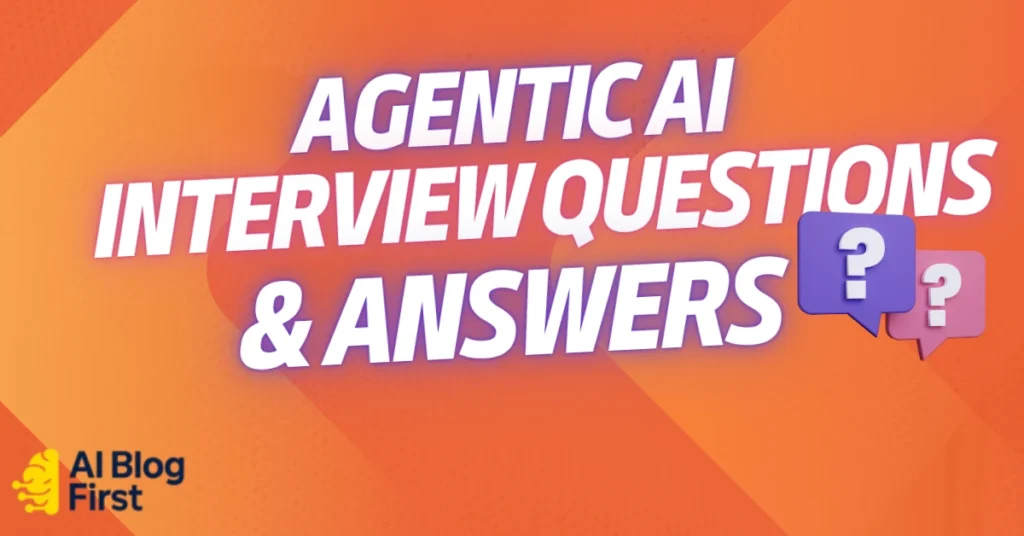
Stepping into an interview for an Agentic AI role feels different, doesn’t it? It’s no longer just about reciting definitions. Companies now want to see if you truly understand how to build systems that can think, plan, and act on their own.
This guide is designed to bridge that gap. We’ve gathered the essential questions you’ll face, from core concepts to complex design challenges, helping you prepare thoughtful answers that showcase real expertise. Let’s get you ready to walk into that room with confidence and land the job.
What is Agentic AI and How Does it Differ from Traditional AI Models?
Before diving into specific questions, it’s crucial to have a rock-solid understanding of what Agentic AI truly is. Think of it as the evolution from a reactive assistant to a proactive partner.
Agentic AI refers to AI systems that can operate autonomously to achieve goals without constant human supervision. These systems don’t just respond to prompts; they can plan, reason, and use external tools to execute multi-step tasks independently. For example, instead of just telling you it’s raining, an agentic AI could check the weather API, determine you have a meeting, book you a cab, and remind you to take an umbrella—all on its own.
Traditional AI, on the other hand, is mostly reactive. It operates on predefined rules or responds directly to user input. A standard chatbot that answers your questions is a classic example of traditional AI. It waits for you to ask something and then provides an answer based on its training data.
Here’s a quick breakdown of the key differences:
| Aspect | Traditional AI | Agentic AI |
| Nature | Reactive; responds only when prompted. | Proactive; can initiate actions and make decisions independently . |
| Autonomy | Limited; follows predefined instructions. | High; plans and executes tasks to meet goals autonomously . |
| Core Function | It responds to user queries. | It acts to achieve objectives . |
| Learning | Learns from data but often needs human guidance to apply it. | Learns from its actions and feedback, adapting its behavior over time . |
The Core Components of an Agentic AI System: Planning, Memory, and Tools
An agentic system’s ability to act autonomously isn’t magic. It’s built on three architectural pillars that you must be able to explain in an interview.
- Planning: This is the agent’s ability to break down a high-level goal into smaller, manageable steps. For a goal like “Plan a weekend trip to Paris,” the agent would create a sequence of tasks: search for flights, find hotel options, check for local events, and create an itinerary. Effective planning is what separates an agent from a simple one-shot tool.
- Memory: To complete complex tasks, an agent needs to remember things. This includes short-term memory (a “scratchpad” for the current task) and long-term memory (storing past interactions, user preferences, or learned knowledge). Memory allows the agent to maintain context, learn from experience, and provide personalized responses.
- Tools: Agents are not all-knowing. Their power comes from their ability to use external “tools” to gather information or perform actions. These tools are often APIs for other services, like a weather forecast API, a web search tool, a code execution environment, or a flight booking system. Tool use extends the agent’s capabilities far beyond its internal knowledge.
Top Agentic AI Interview Questions for Foundational Knowledge
This section covers the basic but non-negotiable concepts you need to know. Nailing these questions shows you have a strong foundation.
1. Can You Explain the Difference Between Reactive and Proactive AI Agents?
What the interviewer is looking for: They are testing your understanding of the fundamental shift in AI behavior. Your answer should be clear, concise, and backed by a simple example.
Sample Answer:
“A reactive agent operates on a simple ‘condition-action’ rule. It perceives its environment and reacts to the current state without considering the past or future. A classic example is a thermostat that turns on the heat only when the temperature drops below a set point.
A proactive agent, which is the essence of Agentic AI, is goal-oriented and autonomous. It doesn’t just react; it takes initiative to achieve its objectives. For instance, a proactive smart home agent wouldn’t just turn on the lights when you arrive; it might learn your routine and adjust the lighting, temperature, and music minutes before you get home to create a welcoming environment. The key difference is the ability to act independently to pursue a defined goal.”
2. How Does an Agentic AI System Use ‘Tools’ to Accomplish a Goal?
What the interviewer is looking for: They want to know if you understand how agents interact with the outside world. This question assesses your knowledge of practical implementation.
Sample Answer:
“An agentic system uses tools by treating them as functions it can call to get information or perform actions that it can’t do on its own. This process usually involves a Large Language Model (LLM) acting as a reasoning engine.
Here’s how it works:
Goal Recognition: The agent is given a goal, like ‘What’s the weather in London?’
- Tool Selection: The LLM recognizes that it cannot know real-time weather. Based on its training and the descriptions of available tools, it decides to use a ‘weather_api’ tool.
- Function Call: The agent formats a request to the weather API, specifying ‘London’ as the parameter.
- Observation: The agent receives the output from the API, for example, ’15°C and cloudy.’
- Response Generation: The agent then uses this new information to formulate the final answer for the user.
This ability to dynamically select and use tools is what allows agents to solve complex, real-world problems.”
3. Describe a Real-World Example of an Agentic AI Application.
What the interviewer is looking for: They want to see if you can connect abstract concepts to tangible products or systems. Use a well-known example and break down its agentic components.
Sample Answer:
“A great example is a self-driving car. Its primary goal is to transport passengers from Point A to Point B safely and efficiently.
It demonstrates agentic behavior through its core components:
- Planning: It doesn’t just react to the car in front of it. It plans the entire route, makes decisions about when to change lanes, and calculates the optimal speed based on traffic and road conditions.
- Memory: It remembers the planned route, speed limits on different roads, and learns from previous drives to improve its performance.
- Tools: It uses a suite of tools to perceive its environment. These ‘tools’ are its sensors: GPS for location, cameras for visual recognition of lanes and obstacles, and LiDAR for measuring distances.
It combines inputs from all these tools to make autonomous decisions, like braking for a pedestrian or navigating a complex intersection, without requiring real-time human commands.”
Agentic AI Interview Questions for System Design and Architecture
These questions move beyond definitions and into the “how.” They test your ability to think like an engineer who builds these systems.
4. How Would You Design an Agentic System to Handle Multi-Step Tasks?
What the interviewer is looking for: This is a core system design question. Your answer should demonstrate your understanding of task decomposition and state management.
Sample Answer:
“I would design it using a task decomposition and execution loop. First, a ‘planner’ agent would break down the main goal—for example, ‘research and write a blog post about Agentic AI’—into a sequence of smaller sub-tasks:
- Search online for top articles on ‘Agentic AI’.
- Synthesize the key findings into an outline.
- Draft the content for each section of the outline.
- Review and format the final draft.
Next, an ‘executor’ agent would tackle each sub-task one by one. I would manage the state of the overall task by storing the plan and the results of each completed step in its memory. Frameworks like LangChain or CrewAI provide useful abstractions for this, allowing different agents to collaborate, with one agent’s output serving as the input for the next.”
5. What Role Does a Feedback Loop Play in an Agentic AI Workflow?
What the interviewer is looking for: They’re checking if you understand how agents learn and self-correct—a critical feature for true autonomy.
Sample Answer:
“A feedback loop is what enables an agent to improve and adapt. It’s a mechanism for the agent to assess the outcome of its actions and adjust its future behavior. This is sometimes called a reflection loop or an Agentic Enrichment Loop.
For instance, if an agent uses a tool and gets an error, a feedback loop allows it to recognize the failure, analyze the error message, and decide on a different approach—like trying a different tool or modifying its parameters. It’s not just about error handling; it’s about learning. If an agent’s summary of a document is deemed ‘too brief’ by a human user, that feedback can be used to refine its ‘summarization’ strategy for the next time. This continuous cycle of acting, observing, and refining is what makes agents truly intelligent.”
6. How Do You Ensure Safety and Prevent Errors in an Autonomous AI Agent?
What the interviewer is looking for: This is a critical question about responsibility and risk mitigation. Your answer should show that you think about limitations and safeguards, not just capabilities.
Sample Answer:
“Ensuring safety is paramount. I’d use a multi-layered approach:
- Clear Constraints: Define strict rules and constraints in the system prompt. For example, an agent should be explicitly instructed ‘You must not execute any command that deletes a file’ or ‘You must always ask for confirmation before making a purchase.’
- Tool Limitation: Limit the tools the agent has access to. An agent designed for research shouldn’t have access to an API that can send emails or spend money.
- Validation and Sanitization: Sanitize all inputs to protect against prompt injection, where a user might try to trick the agent into ignoring its original instructions.
- Human-in-the-Loop (HITL): For high-stakes actions, build in a confirmation step where a human must approve the agent’s plan before it’s executed. This keeps a final, critical checkpoint in place.”
Advanced Technical Agentic AI Interview Questions
These questions are for senior roles and test your deep technical expertise.
7. What are the Key Considerations for Memory and Context in Agentic AI?
Sample Answer:
“The key is to manage both short-term memory for immediate context and long-term memory for retained knowledge.
- Short-term memory acts as a ‘scratchpad’ for the current task. It holds the plan, the results of recent tool uses, and the conversation history. This is crucial for maintaining context within a single, multi-step operation.
- Long-term memory allows the agent to recall information across different sessions. This is often implemented using a vector database, where past interactions and learned facts are stored as embeddings. This enables personalization, as the agent can remember a user’s preferences or previous queries.”
8. How Would You Implement Error Handling and Recovery for an AI Agent?
Sample Answer:
“My approach would be to build a robust error handling strategy that allows the agent to recover gracefully.
- Retry Mechanisms: For transient errors, like a temporary API failure, the agent should be programmed to wait and retry the action a few times.
- Tool Fallbacks: If a primary tool fails consistently, the agent should be able to try an alternative. For example, if a specific search API is down, it could switch to a different one.
- Self-Correction: The agent should be able to analyze the error message. If it’s a syntax error in its own generated code, it should attempt to fix the code and try again.
- Escalation: If the agent is unable to resolve the error on its own after several attempts, it should escalate the issue to a human operator, providing a full report of what it tried to do and why it failed.”
9. Explain the Role of LLMs and Prompt Engineering in Building AI Agents.
Sample Answer:
“The LLM is the ‘brain’ or the central reasoning engine of the agent. Prompt engineering is how we instruct and guide that brain. A crucial concept here is the difference between a System Prompt and a User Prompt.
The System Prompt is the foundational instruction that defines the agent’s persona, goals, and constraints. It’s hidden from the end-user and sets the rules of engagement. For example: ‘You are a helpful AI assistant. You must not give financial advice. Your goal is to help users write code.’
The User Prompt is the specific request from the user, like ‘Write a Python function to sort a list.’
Effective prompt engineering involves crafting a system prompt that gives the agent a clear purpose while also building in safeguards. The LLM uses this prompt, along with the user’s request and its tools, to decide what to do next.”
Preparing for Your Agentic AI Interview: A Case-Based Question
Interviewers love case studies to see how you think on your feet. Be prepared for one.
10. (Case Study) Design an Agentic AI to Automate a Code Review Process.
What the interviewer is looking for: They don’t expect a perfect solution. They want to see your thought process. Break the problem down logically.
How to Approach the Answer:
“First, I would clarify the primary goal: Is it to find bugs, enforce style guidelines, or suggest performance improvements? Let’s assume it’s all three.
- Define the Goal: The agent’s objective is to analyze a pull request, identify potential issues, and provide constructive feedback to the developer.
- Decompose the Task: I would design a multi-agent workflow.
- Agent 1: The Linter: This agent would use a ‘linter’ tool to check for code style and syntax errors.
- Agent 2: The Tester: This agent would use a ‘test runner’ tool to execute unit tests and report any failures.
- Agent 3: The Critic: This is the core LLM-based agent. It would review the code for logical errors, security vulnerabilities, or performance bottlenecks that static tools might miss.
- Agent 4: The Reporter: This final agent would collect the findings from all other agents, synthesize them into a single, polite, and actionable comment, and post it to the pull request.
- Identify Tools: The necessary tools would be APIs for the version control system (like GitHub), a code linter, and a test execution environment.
- Consider Safety: A key constraint would be that the agent can only comment on code—it cannot approve, merge, or delete branches. All its suggestions would need to be reviewed by a human developer.”
Beyond the Buzzwords: How to Prepare for an Agentic AI Job Interview
Simply knowing the definitions isn’t enough. Agentic AI is a practical field, and interviewers value hands-on experience above all else.
The best way to prepare is to build something. Create a personal project that solves a real problem, even if it’s a small one. Whether it’s a research assistant that synthesizes articles for you or an agent that automates your meeting prep, a real project forces you to confront the real-world challenges of building agentic systems.
When you discuss your project, be ready to explain your design choices, the trade-offs you made, and the failures you encountered along the way. Explaining how you debugged an agent that was stuck in a loop is far more impressive than just listing buzzwords.
Frequently Asked Questions (FAQ) About Agentic AI Interviews
What are the most important skills for an Agentic AI role?
Beyond core AI/ML knowledge, the most important skills are system design, API integration, problem decomposition, and strong prompt engineering. Experience with frameworks like LangChain, Llama-Index, or CrewAI is also highly valued.
Is Agentic AI the future of artificial intelligence?
Many experts believe so. The shift from reactive to proactive, autonomous systems represents a major leap in AI’s utility. As these systems become more capable and reliable, they are expected to be integrated into nearly every industry, from customer service to scientific discovery.
Your Next Steps to Ace Agentic AI Interviews
Mastering these Agentic AI interview questions opens the door to today’s most dynamic tech roles. Each concept you’ve learned here brings you a step closer to success and confidence in your next interview.
Ready to transform your AI career? Bookmark this guide for future reference and share it with your network—then explore more hands-on AI tips and job-winning strategies right here on the blog!


